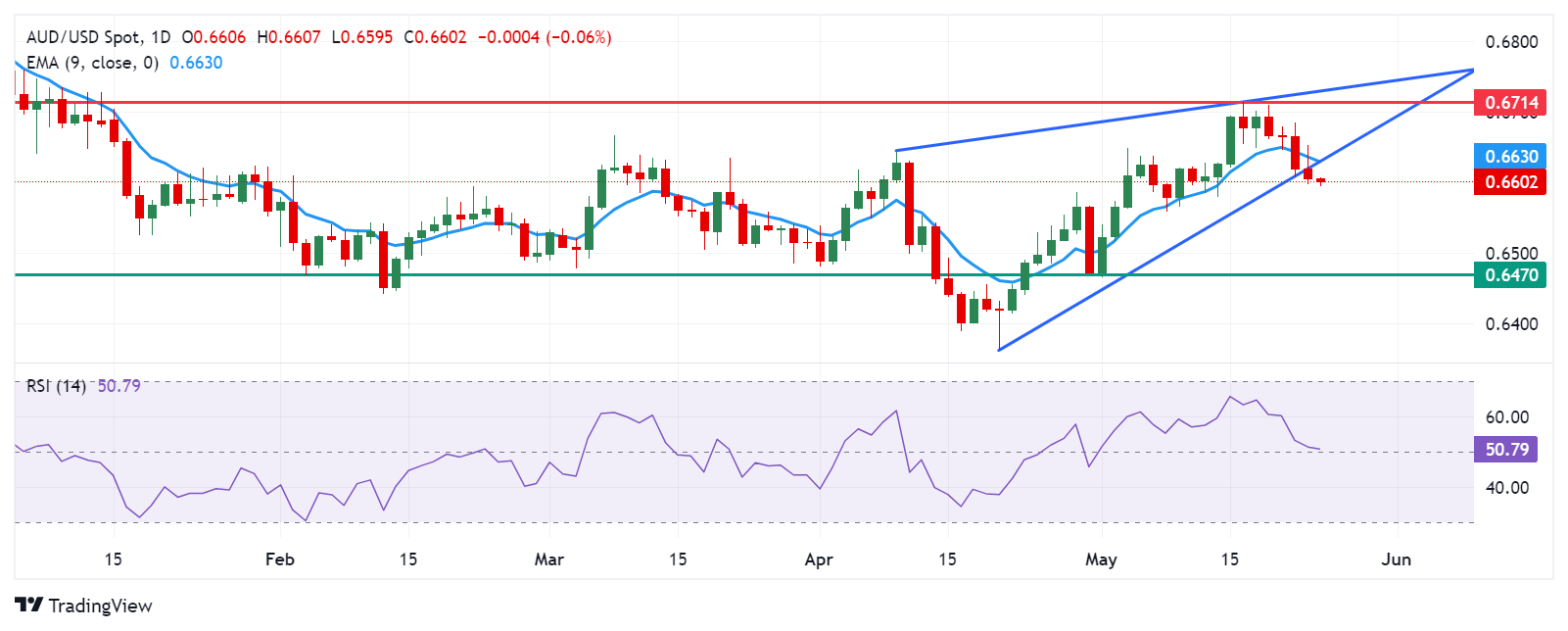Australian Dollar extends losses due to risk aversion after stronger US PMI
- The Australian Dollar continues to lose ground after the release of higher-than-expected US PMI data.
- Australian equities faced pressure due to the lower commodity prices amid hawkish sentiment surrounding the Fed.
- US Dollar gained ground after FOMC Minutes suggested a lack of progress on inflation.
The Australian Dollar (AUD) continues its losing streak for the fourth successive session on Friday, possibly driven by risk aversion. The AUD/USD pair experiences downside as the US Dollar (USD) advances on hawkish sentiment surrounding the Federal Reserve (Fed) of maintaining higher policy rates for an extended period.
The Australian Dollar came under pressure as the Consumer Inflation Expectation of future inflation over the next 12 months fell to 4.1% in May from 4.6% in April, marking the lowest level since October 2021. This has increased the risk of inflation remaining above the target for an extended period. The latest Reserve Bank of Australia (RBA) meeting minutes showed that the policymakers agreed that it was challenging to either rule in or rule out future changes in the cash rate.
The US Dollar (USD) extends its gains as higher-than-expected Purchasing Managers Index (PMI) data from the United States (US), was released on Thursday. The data raised concerns that interest rates will remain elevated for much more time, sending Treasury yields higher. Additionally, the latest Federal Open Market Committee (FOMC) Minutes showed that Fed policymakers expressed concerns about the lack of progress on inflation, which was more persistent than expected at the start of 2024.
Daily Digest Market Movers: Australian Dollar extends losses due to risk aversion
- The ASX 200 Index has rebounded, trading around 7,740 on Friday. However, Australian equities faced pressure amid lower commodity prices as stronger-than-expected US PMI data raised concerns that the Federal Reserve might maintain higher interest rates for a longer period.
- The S&P Global US Composite PMI surged to 54.4 in May, up from April's 51.3. The index marked the highest level since April 2022 and exceeded market expectations of 51.1. The Service PMI rose to 54.8, indicating the biggest output growth in a year, while the Manufacturing PMI increased to 50.9.
- According to the CME FedWatch Tool, the probability of the Federal Reserve implementing a 25 basis-point rate cut in September has decreased to 46.6% from 49.4% a day earlier.
- The preliminary data showed on Thursday that Australian private sector activity remained expansionary for the fourth straight month in May. The preliminary Judo Bank Composite Purchasing Managers Index (PMI) decreased to 52.6 in May from April’s reading of 53.0, indicating a slight moderation in growth.
- The Judo Bank Australia Services PMI was 53.1 in May, down from April’s reading of 53.6. This marks the fourth consecutive month of expansion, albeit at a slower yet still solid pace. The Manufacturing PMI remained unchanged at 49.6 in May, indicating that manufacturing conditions continued to deteriorate for the fourth consecutive month.
- Reuters cited Chinese state media reports on Thursday, which indicated that China has deployed numerous fighter jets and conducted simulated strikes in the Taiwan Strait and around groups of Taiwan-controlled islands. Any geopolitical tension in the region may impact the Australian market as China and Australia are both close trade partners.
Technical Analysis: Australian Dollar hovers around the psychological level of 0.6600
The Australian Dollar trades around 0.6600 on Friday. Analysis of the daily chart indicates a weakening bullish bias as the AUD/USD pair has breached the lower boundary of a rising wedge. Additionally, the 14-day Relative Strength Index (RSI) is positioned at the 50 level. A further decline in this momentum indicator could confirm a bearish bias.
The major support level at 0.6550 is significant. A continued decline may increase pressure on the AUD/USD pair, potentially driving it toward the throwback support region at 0.6470.
On the upside, the nine-day Exponential Moving Average (EMA) at 0.6630, near the lower boundary of the rising wedge, could pose immediate resistance. A breakthrough above this level could reinforce the prevailing bullish bias for the AUD/USD pair, potentially leading it to reach the major level of 0.6650.
AUD/USD: Daily Chart

Australian Dollar price today
The table below shows the percentage change of the Australian Dollar (AUD) against listed major currencies today. The Australian Dollar was the weakest against the Canadian Dollar.
| USD | EUR | GBP | CAD | AUD | JPY | NZD | CHF | |
| USD | 0.00% | -0.02% | -0.03% | -0.01% | 0.04% | 0.00% | 0.04% | |
| EUR | 0.00% | -0.02% | -0.03% | 0.00% | 0.05% | 0.02% | 0.03% | |
| GBP | 0.03% | 0.02% | -0.01% | 0.02% | 0.07% | 0.05% | 0.07% | |
| CAD | 0.02% | 0.06% | 0.01% | 0.02% | 0.07% | 0.05% | 0.06% | |
| AUD | 0.03% | 0.02% | 0.00% | -0.01% | 0.06% | 0.04% | 0.08% | |
| JPY | -0.05% | -0.04% | -0.06% | -0.08% | -0.05% | 0.00% | 0.00% | |
| NZD | 0.00% | -0.02% | -0.04% | -0.05% | -0.01% | 0.03% | 0.02% | |
| CHF | -0.04% | -0.02% | -0.06% | -0.07% | -0.05% | 0.01% | -0.04% |
The heat map shows percentage changes of major currencies against each other. The base currency is picked from the left column, while the quote currency is picked from the top row. For example, if you pick the Euro from the left column and move along the horizontal line to the Japanese Yen, the percentage change displayed in the box will represent EUR (base)/JPY (quote).
Australian Dollar FAQs
One of the most significant factors for the Australian Dollar (AUD) is the level of interest rates set by the Reserve Bank of Australia (RBA). Because Australia is a resource-rich country another key driver is the price of its biggest export, Iron Ore. The health of the Chinese economy, its largest trading partner, is a factor, as well as inflation in Australia, its growth rate and Trade Balance. Market sentiment – whether investors are taking on more risky assets (risk-on) or seeking safe-havens (risk-off) – is also a factor, with risk-on positive for AUD.
The Reserve Bank of Australia (RBA) influences the Australian Dollar (AUD) by setting the level of interest rates that Australian banks can lend to each other. This influences the level of interest rates in the economy as a whole. The main goal of the RBA is to maintain a stable inflation rate of 2-3% by adjusting interest rates up or down. Relatively high interest rates compared to other major central banks support the AUD, and the opposite for relatively low. The RBA can also use quantitative easing and tightening to influence credit conditions, with the former AUD-negative and the latter AUD-positive.
China is Australia’s largest trading partner so the health of the Chinese economy is a major influence on the value of the Australian Dollar (AUD). When the Chinese economy is doing well it purchases more raw materials, goods and services from Australia, lifting demand for the AUD, and pushing up its value. The opposite is the case when the Chinese economy is not growing as fast as expected. Positive or negative surprises in Chinese growth data, therefore, often have a direct impact on the Australian Dollar and its pairs.
Iron Ore is Australia’s largest export, accounting for $118 billion a year according to data from 2021, with China as its primary destination. The price of Iron Ore, therefore, can be a driver of the Australian Dollar. Generally, if the price of Iron Ore rises, AUD also goes up, as aggregate demand for the currency increases. The opposite is the case if the price of Iron Ore falls. Higher Iron Ore prices also tend to result in a greater likelihood of a positive Trade Balance for Australia, which is also positive of the AUD.
The Trade Balance, which is the difference between what a country earns from its exports versus what it pays for its imports, is another factor that can influence the value of the Australian Dollar. If Australia produces highly sought after exports, then its currency will gain in value purely from the surplus demand created from foreign buyers seeking to purchase its exports versus what it spends to purchase imports. Therefore, a positive net Trade Balance strengthens the AUD, with the opposite effect if the Trade Balance is negative.

